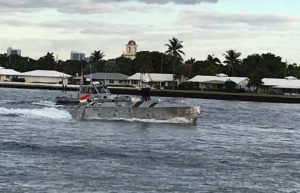The Navy declared the Unmanned Influence Sweep System (UISS) achieved Initial Operating Capability (IOC) on July 22.
“UISS’s declaration of IOC is a monumental achievement for the Navy’s Mine Countermeasures (MCM) Mission Package (MP),” Capt. Godfrey Weekes, LCS Mission Modules (PMS 420) Program Manager, said in a statement on July 28.
UISS is a platform that performs acoustic and magnetic minesweeping while towed from the aluminum-hulled Mine Countermeasures Unmanned Surface Vehicle (MCM USV). The MCM USV is the tow platform for both minesweeping and mine hunting in the MCM MP.

The Navy aims to use the MCM USV to tow the UISS and other platforms to perform the MCM MP operations in an effort to replace the legacy Avenger-class minesweeping ships.
This aims to provide a high area coverage in a relatively small package with minimal impact to the host ship. The UISS work specifically targets acoustic, magnetic, and magnetic/acoustic combination mines.
The MCM USV is primarily planned to be hosted from LCSs, but it can also be operated off vessels of opportunity or from ashore. MCM USV payloads include the Raytheon Technologies [RTX] AN/AQS-20C sonar used to detect, localize and classify bottom, close-tethered moored and volume moored mines.
With IOC, the UISS program has now completed formal testing and delivered a system with logistics and training material and properly trained fleet personnel to conduct minesweeping in the LCS MCM MP.
The Navy underscored this is a turning point in introducing unmanned vessels to the Navy because it is the first IOC of an unmanned surface platform by the service, “marking an important milestone in the evolution toward a hybrid fleet of manned and unmanned systems.”
“Over the years, the program has worked tirelessly to mature and field the UISS system that will keep the Navy’s most valuable asset, our sailors, safer by keeping them out of the minefield. With this declaration, the program is inching closer toward system-wide IOC for the MCM MP,” Weekes added.
Previously, in January, the Navy completed underwater explosion shock testing for the UISS. At the time the Navy said it was on track for IOC in 2022 following shipboard Initial Operational Test and Evaluation (IOT&E) onboard the USS Cincinnati (LCS-20) in June 2021 and Cyber IOT&E in September 2021 (Defense Daily, Jan. 4).
In April, the Navy awarded Bollinger Shipyards a $14 million contract for production of an initial three MCM USVs over two other bids, likely including Textron Systems [TXT]. The contract includes options to procure up to six more vehicles in the base year and options to potentially buy up to 24 additional vehicles (Defense Daily, April 11).
The Navy originally awarded Textron an EMD contract for UISS in 2014 and ultimately contracted for four MSM USVs from the company subsequently used in Navy UISS testing for several years. Textron’s Common Unmanned Surface Vessel (CUSV) was used to tow the UISS in the testing.
The MCM USV is a build-to-print contract, meaning the winner must manufacture the product to specific technical specifications. The Navy ultimately decided Bollinger’s bid was more competitive than Textron despite the latter’s years of work on the program.